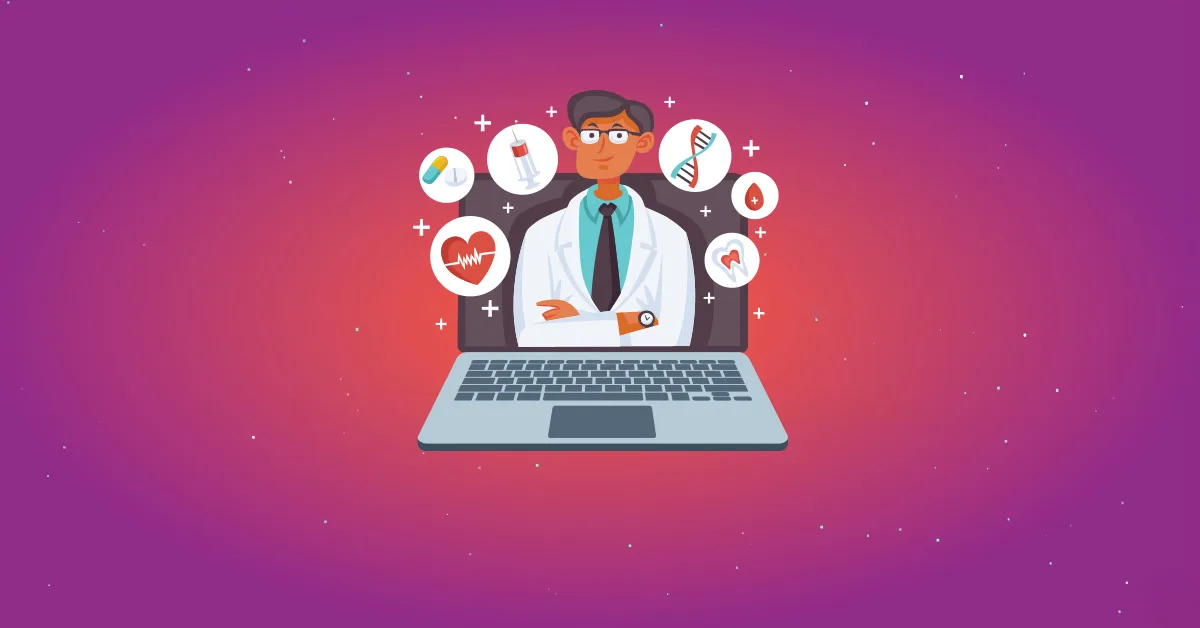Healthcare communication is evolving fast, and health infographics are becoming a great tool to share tricky information in a clear and engaging way. These graphics merge art and data to showcase healthcare concepts in a visually stimulating way.
Medical infographics are really handy for healthcare branding because they can condense large amounts of information into easy-to-understand graphics.
In this guide, we will explore the benefits of infographics in healthcare branding, with real-world examples and strategies.
Why Infographics Are Effective?
Infographics captivate users by blending visual elements and concise information, making complex concepts digestible at a glance. Their potent combination of design and data engages audiences, enhancing comprehension and retention. In the
- Simplify Complex Information: Convert medical complexities into relatable visuals.
- Enhance Memorability: Blend images and text for memorable healthcare insights.
- Foster Engagement: Capture attention, connect, and convey crucial health messages.
- Bridge Communication Gaps: Overcome language barriers with universal infographics.
- Build Brand Identity: Create trust and recognition through branded healthcare visuals.
Benefits of Using Infographics for Healthcare Promotion
Healthcare infographics are essential in medical promotion, simplifying complex information and improving engagement, retention, and sharing on social media. They revolutionize the way medical concepts are communicated.
1. Simplifying Medical Concepts
Medical terminology can pose challenges, particularly for patients and non-healthcare individuals. Infographics prove invaluable by deconstructing intricate medical concepts into comprehensible visuals. Through concise text, symbols, and images, these graphics simplify complex information, aiding patient understanding and informed decision-making regarding their well-being.
2. Increasing Engagement
Did you know that people tend to pay more attention to visual content than just plain text? That’s why infographics are so effective in healthcare content. They make use of our natural preference for visuals, resulting in better engagement. When you see a well-designed infographic, you tend to spend more time on it, which means you understand and remember the information better. This can help patients connect better with their healthcare providers, leading to better education and satisfaction.
3. Enhancing Brand Visibility
When it comes to healthcare institutions and professionals, having a strong brand presence is super important. Infographics are a great way to do this because you can incorporate your brand’s colors, logos, and design elements. By consistently using these visual cues across all your infographics, you can create a cohesive and recognizable brand image. This not only builds trust and credibility for your brand infographics but also makes sure that any information you share is attributed to you as the healthcare provider.
4. Improved Information Retention
Infographics offer remarkable utility by fusing imagery and text, enhancing information retention. Research indicates that visual stimuli enhance memory recall. In healthcare, this holds paramount significance as patient comprehension of medical instructions and adherence to treatment regimens greatly influence outcomes. Infographics effectively render intricate medical details more memorable and comprehensible, benefiting all parties involved.
5. Shareability and Increased Social Media Traction
In today’s world of social media, information can spread like wildfire. Luckily, infographics are perfect for sharing because they’re visually stunning and easy to understand. Healthcare providers can use this to their advantage by creating and sharing healthcare-related infographics. When patients and followers share these infographics on their social media accounts, the information can reach a much wider audience. This can help promote health awareness and show that the healthcare provider is a trustworthy source of accurate information.
Types of Healthcare Information Ideal for Infographic Representation
Infographics prove exceptionally valuable in simplifying intricate healthcare information, empowering individuals to grasp it effortlessly. By selecting relevant healthcare data, employing precise visualizations, and referencing reliable sources, you can create infographics that educate, inspire, and promote enhanced health behaviors effectively.
1. Disease Prevention: Visualizing Healthy Habits
- Lifestyle Factors: Illustrate the impact of exercise, balanced nutrition, sleep, and stress management on overall health.
- Immunization Schedules: Present vaccination timelines for different age groups to promote immunization awareness.
- Hygiene Practices: Showcase effective hygiene routines to prevent the spread of infections and diseases.
2. Treatment Methods: Simplifying Complex Approaches
- Medication Guides: Condense medication information, dosages, and schedules for improved patient understanding.
- Therapeutic Techniques: Visualize diverse treatment methods like physical therapy exercises, breathing techniques, and mindfulness practices.
- Surgery Insights: Break down surgical procedures, step-by-step, to alleviate patient anxiety and enhance comprehension.
3. Health Tips: Bite-sized Wellness Advice
- Nutritional Charts: Create visual guides to balanced diets, portion control, and recommended daily intake of nutrients.
- Fitness Demonstrations: Show how to perform exercises with proper form, highlighting the muscle groups targeted and potential benefits.
- Self-Care Rituals: Map out self-care routines encompassing skincare, relaxation techniques, and mental health exercises.
4. Statistics and Epidemiology: Making Numbers Meaningful
- Incidence Rates: Translate epidemiological data into visual representations, aiding in the understanding of disease occurrence.
- Prevalence Mapping: Create geographical heat maps to depict the distribution of specific health conditions across regions.
- Comparative Analysis: Use graphs and charts to compare health indicators, treatment outcomes, and medical advancements.
Emphasizing Accurate Data Representation and Sourcing
Infographics wield substantial influence, but their effectiveness hinges on the reliability of the data they convey. To ensure credibility, you can take the following initiatives:
- Source Verification: Rely on reputable medical journals, healthcare organizations, and government health agencies for accurate and up-to-date information.
- Cite Sources: Include citations within the infographic or accompanying materials to allow viewers to access the original data.
- Fact-Checking: Thoroughly review the data for accuracy and consistency before finalizing the infographic.
- Visual Clarity: Prioritize clarity in visual elements to prevent misinterpretation and confusion.
- Transparency: Clearly indicate the time frame of the data and any potential limitations to provide a well-rounded perspective.
Design Principles for Creating Engaging Healthcare Infographics
Crafting compelling healthcare infographics hinges on thoughtful design principles. Balancing informative content with captivating visuals ensures both clarity and engagement, effectively conveying complex medical concepts to diverse audiences.
1. Clear and Concise Messaging
Healthcare infographics must convey information clearly and simply, using straightforward language. Prioritize key messages and focus on the most relevant information to ensure your audience understands the topic.
2. Thoughtful Color Choices
Choose colors carefully when designing healthcare infographics. Use a palette that matches the subject matter and its intended emotions. Avoid overwhelming viewers with too many colors.
3. Typography for Readability
Choose clear and legible fonts for healthcare infographics. Use proper font sizes and maintain consistency throughout to create a seamless visual experience. Typography greatly impacts readability.
4. Establishing a Visual Hierarchy
To create engaging healthcare infographics, use varying sizes, colors, and placements to highlight important elements and ensure a clear visual hierarchy. This helps viewers grasp critical information quickly.
Incorporating Branding Elements while Maintaining Visual Appeal
Infographics are a fantastic way to showcase your brand while also providing helpful information. If you’re wondering how to incorporate branding elements without sacrificing visual appeal, here are some tips:
- Color Consistency: Align your infographic’s color scheme with your brand’s colors. This reinforces brand recognition and maintains a cohesive visual identity.
- Subtle Logos: Place your brand logo discreetly in a corner or at the bottom of the infographic. The logo should be present without overshadowing the content.
- Font Selection: Use fonts that resonate with your brand’s tone. Whether it’s formal, friendly, or innovative, the typography should reflect your brand’s personality.
- Iconography and Illustrations: Develop a set of branded icons or illustrations that can be integrated into the infographic. These visual cues can make your infographic more engaging and unique to your brand.
- Consistent Style: Ensure that the overall style of the infographic aligns with your brand’s visual style. Consistency in design elements will enhance recognition and maintain a professional appearance.
Tools and Resources for Crafting Effective Healthcare Infographics
When you’re working with these tools and resources, just remember to keep in mind the tone and target audience of your content. It’s also really helpful to stick to a consistent visual style that reflects your brand if applicable. Healthcare professionals and communicators can use these tools to create infographics that educate and inspire their audiences. This can help people make better decisions and understand medical concepts more easily.
1. Canva
Canva is great for healthcare infographics with its easy-to-use interface, healthcare templates, and stock photos. You can customize templates and add branding elements to suit your messaging needs.
2. Piktochart
Piktochart simplifies infographic design with healthcare templates and interactive features. You can use this tool to import data, visualize statistics, and create informative charts and graphs seamlessly.
3. Venngage
Venngage is a great tool for healthcare professionals looking to visually present complex medical data. It offers a diverse library of charts, maps, and icons, along with healthcare-specific templates that help communicate information effectively.
4. Stock Photo Websites for Visual Impact
Enhance the quality of your healthcare infographics by integrating visually striking images from stock photo websites. Some reputable platforms to consider include:
- Unsplash: Offers a vast collection of high-quality, royalty-free images that can add depth and visual appeal to your infographics.
- Pixabay: Provides a wide range of medical and healthcare-related images that can complement your content seamlessly.
5. Data Visualization Tools for In-depth Insight
Incorporating data-driven insights into your health infographics requires robust visualization tools. Consider tools like:
- Tableau Public: This tool offers a powerful data visualization platform that helps transform complex healthcare data into interactive and visually engaging graphics.
- Infogram: This tool allows you to create charts, graphs, and interactive maps that effectively communicate healthcare statistics and trends.
Design Guidelines Tailored for Healthcare Infographics
If you want to make health infographics that are easy to understand and look great, there are a few things you should keep in mind. The most important thing is to use visuals that your audience will connect with and make complex information simple. You can try using medical illustrations, icons, and charts to achieve this.
It’s crucial to ensure that your infographics are accurate and trustworthy. Make sure that the design is in sync with the facts to create something that’s both engaging and informative.
Ensuring Credibility and Accuracy in Health Infographics
To create trustworthy healthcare infographics, it’s crucial to fact-check all your sources. This means using reliable and current information, as well as citing any medical studies or research that supports your claims. Collaborating with healthcare professionals like doctors or researchers can also provide valuable assistance. By prioritizing accuracy, you’ll build trust with your audience and empower them to make informed healthcare decisions.
Successful Healthcare Brand Infographic Examples
We’ve got some best healthcare branding examples of how businesses have used infographics to shed light on the medical and healthcare world. These examples are proof that health infographics can be engaging, informative, and motivating. If you’re looking to create your own healthcare infographics, remember that a mix of creativity and useful information can really help you stand out.
OhioHealth
Check out OhioHealth’s amazing infographics! They simplify complex topics and make them visually appealing. One of our favorites is about phytonutrients and which foods to eat. They also have great healthcare infographic examples, such as one about coffee and exercises for lower back pain.
Improving Patient Education and Engagement with Infographics
Did you know that using health infographics in patient education can help improve communication between healthcare providers and patients? It can also lead to better decision-making and improved overall outcomes for patients.
- Enhancing Communication: Infographics serve as a powerful tool for healthcare providers to convey complex treatment options, procedures, and medication information in a visually engaging manner.
- Simplifying Complex Concepts: By breaking down intricate medical concepts into easily digestible visuals, infographics empower patients to better grasp their healthcare journey.
- Promoting Patient Understanding: Visual representations enable patients to understand their conditions, treatments, and expected outcomes, fostering a sense of empowerment and active participation in their care.
- Boosting Compliance: Clear and concise infographics can lead to improved patient compliance, as patients are more likely to adhere to treatment plans when they fully comprehend the rationale behind them.
Measuring the Impact of Health Infographic Campaigns
When it comes to healthcare infographics, it’s essential to measure their impact to make sure they’re reaching people effectively. This involves looking at how engaged people are with the content, how often it’s shared on social media, how many people are visiting the website, and how many are actually taking action based on what they’ve learned.
By tracking these metrics and adjusting strategies as needed, you can create useful, relevant, and valuable infographics for a wide range of people who need healthcare information.
Tracking Engagement Metrics
Engagement metrics provide valuable insights into the level of interaction and interest generated by healthcare infographic campaigns. These metrics include:
- Click-Through Rates (CTR): Measure the percentage of viewers who click on the infographic to learn more. It indicates the campaign’s ability to capture attention and encourage further exploration.
- Time Spent: Monitoring the average time viewers interact with the infographic. Longer durations suggest higher engagement and a deeper understanding of the content.
- Scroll Depth: Analyzing how far users scroll through an infographic. Deeper scrolls indicate sustained interest and commitment to exploring the entire piece.
Monitoring Social Media Shares
Social media platforms are a prime avenue for sharing infographics and gauging their impact. Tracking social media shares offers insights into the campaign’s reach and resonance:
- Share Count: This entails quantifying the number of times the infographic is shared across various platforms. This metric reflects the campaign’s virality and its ability to spark conversations.
- Likes, Comments, and Reactions: This involves evaluating the engagement level through likes, comments, and reactions to the shared infographic. High interaction rates signify strong audience involvement.
Analyzing Website Traffic
Website traffic metrics unveil the effectiveness of healthcare infographic campaigns in driving audiences to the designated landing page:
- Page Views: Counting the number of times the infographic page is accessed. A significant increase indicates successful promotion and interest generation.
- Bounce Rate: Examining the percentage of users who leave the page without interacting further. A lower bounce rate signifies engaging and relevant content.
- Navigation Path: Tracking the sequence of pages visited after interacting with the infographic. Understanding user journeys provides insights into their interests and subsequent actions.
Measuring Conversion Rates
Conversion rates highlight the ultimate success of healthcare infographic campaigns in achieving their intended goals:
- Lead Generation: Tracking the number of visitors who take a desired action, such as signing up for a newsletter or downloading a related resource. This is another place where you use infographics for marketing.
- Call-to-Action (CTA) Clicks: Evaluating the number of users who click on CTAs within the infographic, such as “Learn More” buttons or “Contact Us” links.
Refining Strategies through Performance Analytics
The true power of healthcare infographic campaigns lies in their ability to adapt and improve based on data-driven insights. The iterative process involves:
- Data Analysis: Thoroughly examining the collected metrics to identify patterns, trends, and areas for improvement.
- Identifying Key Insights: Pinpointing the most successful aspects of the campaign, such as specific content topics, visual elements, or distribution channels.
- A/B Testing: Experimenting with variations of infographics to test hypotheses and refine strategies based on comparative performance.
- Content Optimization: Fine-tuning content, design, and messaging based on audience preferences and engagement behaviors.
- Iterative Deployment: Releasing updated infographics and closely monitoring their performance to ensure ongoing refinement.
In Summary
Health infographics simplify complex medical information, fostering engagement and aiding patient education. Benefits include conveying medical concepts, enhancing engagement, and facilitating social sharing. They excel in disease prevention, treatment methods, health tips, and statistics communication. To ensure credibility, verify sources, fact-check, and utilize transparent visuals.
If you want to harness the potential of infographics in healthcare, connect with Digital Caterpillar. Our adept professionals specialize in creating impactful visuals and ensuring effective communication of medical insights.










